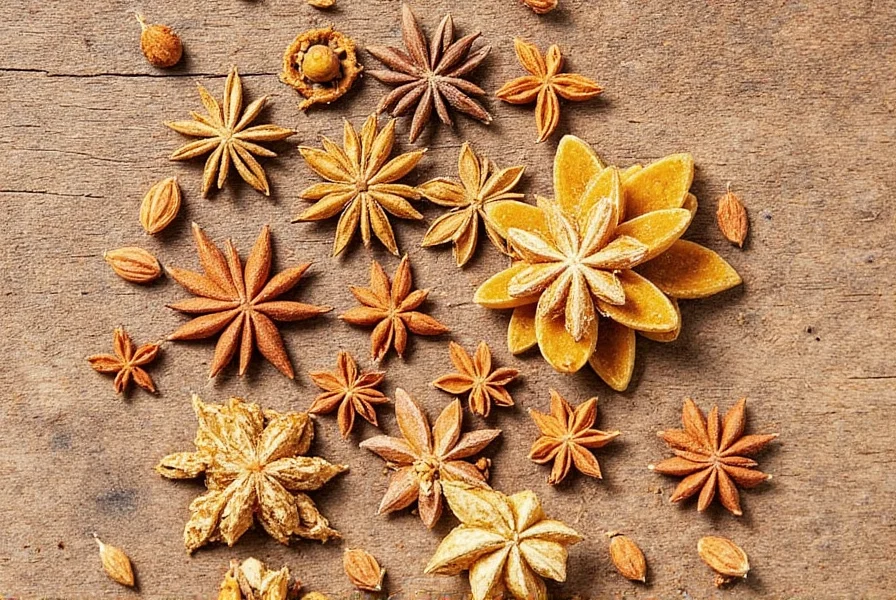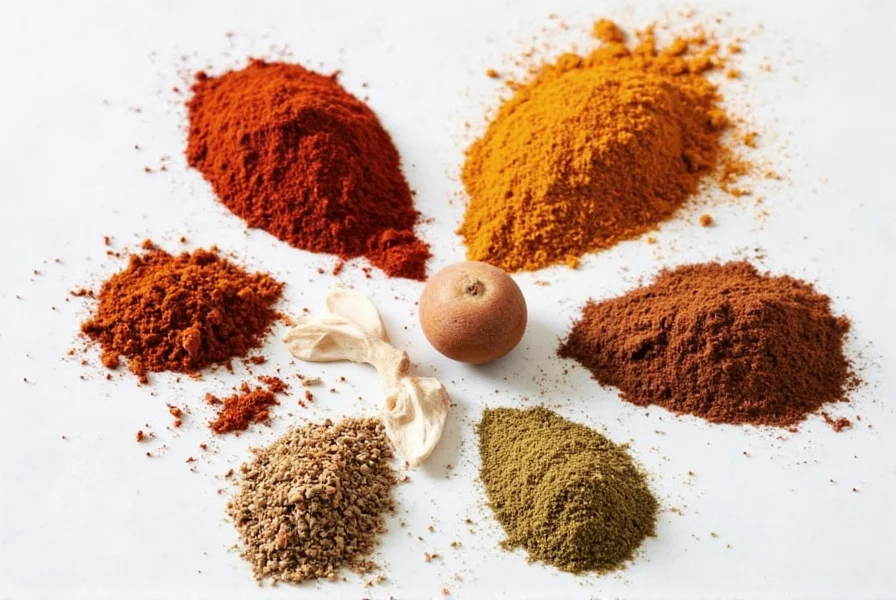Top 10 Beef Spices for Stew
Transform your beef stew with these 10 essential spices. This guide covers precise measurements, pairing tips for different beef cuts, expert timing advice, and flavor profiles to maximize flavor.
Top 10 Beef Spices for Stew
These spices form the foundation of a flavorful beef stew. Here's what you need:
| Spice | Flavor Profile | Ideal For | Quantity per 2 lbs Beef |
|---|---|---|---|
| Bouquet Garni | Herbal, earthy, aromatic | Classic French stews | 1 bundle or 1 tsp dried |
| Paprika | Sweet, smoky (depending on type) | Color and depth | 1–2 tsp |
| Bay Leaf | Woody, mint-like aroma | Broths and long simmers | 1–2 leaves |
| Black Pepper | Pungent, sharp | Enhancing other flavors | To taste |
| Garlic Powder | Strong, savory, umami-rich | Meaty depth | 1 tsp |
| Thyme | Earthy, slightly minty | Tomato-based or root veggie stews | 1–2 tsp fresh or dried |
| Rosemary | Pine-like, resinous | Hearty stews with potatoes | ½ tsp crushed |
| Cumin | Earthy, nutty, warm | Middle Eastern or North African fusion | ½–1 tsp |
| Nutmeg | Warm, sweet, musky | Cream-based stews or white sauces | A pinch |
| Mustard Powder | Sharp, tangy | Adding backbone to broth | ½ tsp |

Understanding Flavor Profiles
Mastering spice combinations elevates your stew. Here's how key profiles work:
- Earthy: Rosemary, Thyme, Bay Leaf — form the backbone of classic stews.
- Smoky/Sweet: Smoked paprika adds color and depth without overpowering.
- Umami Boosters: Garlic powder and mustard powder enhance meaty richness.
- Warm & Inviting: Nutmeg and cumin provide cozy complexity.
Pairing Spices with Cuts of Beef
Different cuts require tailored spice approaches:
| Cut | Texture | Best Spice Matches | Tips |
|---|---|---|---|
| Chuck Roast | Fatty and tough | Thyme, rosemary, bay leaf | Simmer 2–3 hours for full flavor infusion |
| Brisket | Very tough, high collagen | Black pepper, garlic powder, paprika | Base for Texas-style beef stew |
| Shank | Marbled and gelatin-rich | Cumin, thyme, bay | Perfect for osso buco-inspired stews |
| Stewing Beef | Pre-cut lean pieces | Bouquet garni, mustard powder | Great for one-pot meals |
How to Use Spices in Stews Like a Pro
Timing is critical for optimal flavor development:
- At the beginning: Hardy herbs (thyme, bay leaf, bouquet garni) — add early to bloom flavors slowly.
- Midway through: Garlic powder, paprika, black pepper — after browning meat but before adding liquids.
- Toward the end: Freshly cracked black pepper or nutmeg — enhances complexity without overpowering.
- Finishing touches: Fresh herbs or smoked paprika — for visual appeal and aromatic finish.
Frequently Asked Questions About Beef Spices for Stew
How much spice should I use in a beef stew?
Start with smaller amounts (½-1 tsp for most dried spices per 2 lbs beef) and adjust to taste. Flavors intensify during simmering, so add incrementally. Remember: You can always add more, but you can't remove excess.
What's the difference between fresh and dried herbs in beef stew?
Dried herbs (1/3 the amount of fresh) withstand long cooking and release concentrated flavor. Fresh herbs (added at the end) provide bright, aromatic notes. For hour-long stews, use dried thyme/rosemary early and fresh parsley at the finish.
Can I over-spice a beef stew?
Yes. Strong spices like cumin or bay leaves can dominate if overused. To fix: Add unsalted tomatoes, a peeled potato, or extra liquid to absorb excess seasoning. Balance with acid (vinegar or lemon juice) to cut through overpowering flavors.
What are the essential spices every beef stew should have?
Core essentials: Bay leaf (foundation), thyme (earthy depth), black pepper (sharp contrast), and garlic powder (umami). Paprika adds color and subtle sweetness, while nutmeg (pinch) rounds out the profile without being noticeable.
When is the best time to add spices during stew preparation?
Hardy herbs (thyme, rosemary, bay) at the start. Medium-intensity spices (paprika, garlic powder) after browning meat but before liquids. Delicate spices (fresh herbs, nutmeg) in the last 10 minutes. This layering creates balanced, complex flavors.
How long do spices keep their potency for beef stew recipes?
Whole spices: 2-3 years. Ground spices: 6-12 months. Test potency by rubbing between fingers — if aroma is weak, replace. Store in airtight containers away from heat and light to extend shelf life.
Buying Guide: Choosing the Best Spice Blends and Individual Spices
Make informed choices with this quick guide:
Individual Spices
- McCormick Culinary Bay Leaves: Large, fragrant leaves for authentic French stews.
- Badia Ground Cumin: Earthy, nutty kick for North African-inspired dishes.
- Spice Islands Dried Thyme: Consistent flavor for blending with other herbs.
- La Flor Smoked Paprika: Deep red color and bold smokiness for rich stews.
Spice Blends
- Penzeys Beef Stew Seasoning: Ready-made blend with salt, garlic, and herbs for quick prep.
- Williams Sonoma French Herbs de Provence: Lavender-infused thyme and rosemary for rustic French stews.
- Ranch Style Stew Mix: Beginner-friendly with cornstarch for easy thickening.
What to Look For
| Product Type | Features | Who It's For | Best Used In |
|---|---|---|---|
| Whole Bay Leaves | Dried, organic, reusable | Home cooks and chefs | Classic stews, soups, braises |
| Ground Paprika | Smoked or sweet varieties | Anyone seeking flavor and color | Tomato-based stews, chili |
| Ready-Made Stew Seasoning | Convenient, pre-mixed | Beginners, busy cooks | Quick beef dishes, camping meals |
| Herb Bundles | Fresh or dried bundles | Experienced cooks | French and Italian-style dishes |

Conclusion
Spices are the secret to transforming humble ingredients into unforgettable meals. Whether you're making a classic beef bourguignon or a bold Moroccan-inspired stew, the right combination creates depth and complexity.
Experiment with these guidelines, taste as you go, and remember: Every great stew starts with perfectly seasoned ingredients.
Happy cooking!










 浙公网安备
33010002000092号
浙公网安备
33010002000092号 浙B2-20120091-4
浙B2-20120091-4